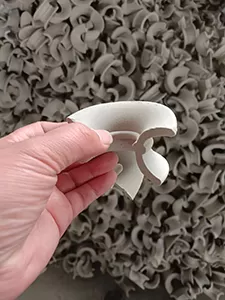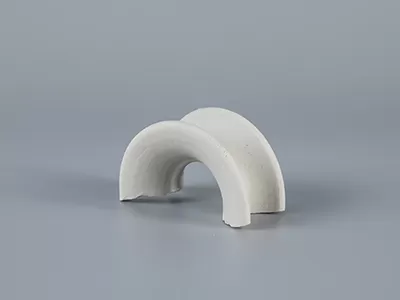The working principle of ceramic Intalox saddle packing is rooted in facilitating efficient mass transfer between gas and liquid phases in industrial separation columns, combining structural geometry and material characteristics to optimize contact, distribution, and separation of components. Its design addresses key challenges in processes like distillation, absorption, and stripping, particularly in environments where corrosion resistance and thermal stability are critical.

At the core of its working principle is the promotion of uniform gas-liquid distribution. The saddle-shaped geometry of ceramic Intalox packing—with curved surfaces and open channels—guides the flow of both phases through the packed bed, minimizing channeling (where fluids flow through preferred paths) and dead zones (areas with little to no phase contact). This uniform distribution ensures that every unit of the packing contributes to mass transfer, maximizing the efficiency of the separation process.
The structural design enhances interfacial contact between phases, a fundamental aspect of its working principle. As liquid flows downward over the ceramic saddle surfaces, it forms thin films due to the material’s surface tension and roughness. Simultaneously, gas flows upward through the open channels, interacting with these liquid films across the curved surfaces. This increased contact area between gas and liquid phases accelerates mass transfer, allowing components to diffuse from one phase to another based on concentration gradients.

Ceramic Intalox saddle packing’s material properties complement its geometric design in the working principle. Ceramic’s chemical inertness ensures that it does not react with corrosive fluids, maintaining its structural integrity and avoiding contamination of the separated components. This stability is crucial in processes involving acids, alkalis, or solvents, where material degradation would disrupt phase contact and reduce separation efficiency over time.
Thermal resilience plays a role in the working principle, particularly in high-temperature applications. Ceramic materials withstand extreme temperatures without warping or deforming, preserving the packing’s geometric structure even under thermal stress. This stability ensures consistent flow patterns and contact efficiency in processes like high-temperature distillation or incineration gas treatment, where temperature fluctuations could compromise the performance of plastic or less robust metal packings.
Liquid retention and film formation are key mechanisms in the working principle. The textured surface of ceramic Intalox saddle packing slows liquid drainage, increasing the residence time of liquid on the packing surface. This extended contact time allows for more thorough mass transfer, as solutes in the gas phase have additional opportunities to dissolve into the liquid phase (or vice versa, depending on the process). The balance between liquid retention and drainage prevents flooding while maintaining optimal film thickness for efficient transfer.
Pressure drop management is an integral part of the working principle. The open channel design and symmetric saddle shape minimize resistance to gas and liquid flow, reducing pressure drop across the packed bed. This allows for energy-efficient operation, as less power is required to pump gases or liquids through the column compared to packings with more restrictive geometries. Lower pressure drop also reduces the risk of liquid entrainment (where liquid droplets are carried upward by the gas flow), preserving phase separation.
The packing’s void fraction—another aspect of its working principle—ensures adequate space for both phases to flow. Ceramic Intalox saddle packing maintains a high void fraction (typically 70–80%), allowing unobstructed gas flow while accommodating liquid hold-up (the volume of liquid retained in the packing bed). This balance prevents excessive pressure build-up and ensures that both phases have sufficient mobility to maintain contact without overwhelming the system.
In corrosive environments, the working principle relies on ceramic’s resistance to chemical attack. Unlike metal packings that may corrode and form irregular surfaces, ceramic Intalox saddles retain their smooth yet textured profile over time. This consistency preserves the intended flow patterns and contact mechanisms, ensuring that the working principle remains effective throughout the packing’s service life, even in prolonged exposure to aggressive chemicals.
The working principle also involves facilitating mass transfer through surface renewal. As liquid flows over the curved saddle surfaces, turbulence is created at the gas-liquid interface, continuously renewing the liquid film and exposing fresh surface area for mass transfer. This surface renewal prevents the formation of stagnant layers that would slow down diffusion, enhancing the overall rate of component separation in the column.
In summary, the working principle of ceramic Intalox saddle packing integrates structural design and material properties to optimize gas-liquid distribution, enhance interfacial contact, manage pressure drop, and maintain stability in harsh environments. By focusing on uniform phase interaction and efficient mass transfer, it enables reliable and effective separation in industrial processes where corrosive or high-temperature conditions demand specialized packing solutions.

